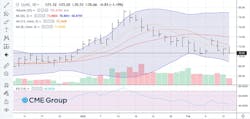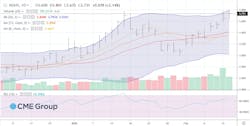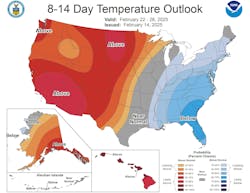Oil, fundamental analysis
Bearish sentiment for oil prices came in many forms this week as the specter of a ceasefire in the Russia/Ukraine war combined with a negative inflation report and a large gain in crude stocks sending prices lower on the week.
The new sanctions on Russian oil exports are starting to show signs of an impact which was the only bullish news this week. WTI saw a High of $73.70/bbl on Tuesday and a Low of $70.25 on Wednesday. Brent hit a High of $77.20 on Tuesday and a Low of $74.10 on Thursday. Both grades settled lower week-on-week. The WTI/Brent spread is currently -$4.10.
After a phone call with Vladimir Putin, US President Trump said Russia would be willing to start peace talks with Ukraine which could lead to a ceasefire in the war. Such action could allow the US to lift the current sanctions on Russian oil exports. However, analysts see Trump’s proposed 25% tariff on steel and aluminum imports as having a negative impact on the global economy which could weigh on oil demand.
The last Biden sanctions on Russian oil exports appear to be having an impact as buyers in Asia, specifically, China and India, look for other sources and as tanker rates to ship the Urals have risen as well. Markets are increasingly reluctant to accept sanctioned shipments. However, the International Energy Agency in Paris believes “work arounds” will happen again noting that Russian oil production has not been lowered by much.
Meanwhile, the Trump administration has imposed new sanctions on people and companies facilitating the sale of Iranian oil to China in an effort to greatly reduce Iran’s oil exports while India has agreed to buy more US oil and LNG to help reduce the trade deficit between the two countries and to help India avoid new tariffs.
Inflation is heading upward, as January’s Consumer Price Index was reported to be 3.0%, up from December’s 2.9% with the monthly price increases alone at +0.5%. In response, the US Federal Reserve expressed concerns over the report and stated that now is not the time to consider any further interest rate cuts. Markets reacted negatively to this news.
The Energy Information Administration’s Weekly Petroleum Status Report indicated that commercial crude oil and distillate inventories increased while gasoline decreased. US oil production was 13.5 million b/d and the Strategic Petroleum Reserve was higher at 395 million bbl.
New claims for unemployment benefits last week were at 213,000, lower than the forecasted 214,000 and the prior week’s 220,000 while continuing claims fell to 1.85 million from 1.89 million. And, despite a dip midweek on the inflation report all 3 major US stock indexes are higher on the week. The USD is lower which may be helping set a floor for crude prices this week.
Oil, technical analysis
March 2025 NYMEX WTI Futures are below the 8-, 13-, and 20-day Moving Averages. Volume is below-average at 180,000. The Relative Strength Indicator (RSI), a momentum indicator, is “slightly-oversold” at the “42” mark. Resistance is now pegged at $71.50 (8-day MA) with near-term Support at $70.50.
Looking ahead
If Russia is truly willing to begin settlement talks with Ukraine, oil prices will go lower especially with the added concerns over the Trump tariffs and the global economy. On the flip side, if no such actions commence soon, the sanctions on Russian exports will remain in-place and, coupled with the sanctions on Iran, oil prices could actually increase.
Overall, however, the economic outlook looks bleak, and most analysts aren’t bullish on prices for 2025. Near-term, the NOAA 8-14-day forecast is bullish for heating oil demand in the Northeast.
Natural gas, fundamental analysis
Natural gas has managed an 8-day uptrend rally on the declining storage volumes and waves of below-normal temperatures that continue to spread across large regions of the US. Additionally, LNG sendout continues to increase and set a new record high. March NYMEX Henry Hub prices had a High of $3.80/MMbtu Friday with a Low of $3.29 on Monday. Supply last week was +0.2 bcfd to 112.5 bcfd vs. 112.3 the prior week. Demand was +11 bcfd to 134.6 bcf vs. 123.6 bcfd the week prior, with the biggest decrease in Residential consumption.
Exports to Mexico were 6.5 bcfd vs. 6.4 the prior week. LNG exports were 15.7 bcfd (a new high) vs. 15.1 bcfd the prior week as Freeport LNG works to get back to full volumes after a storm-related power outage.
The EIA’s Weekly Natural Gas Storage Report indicated a withdrawal of 100 bcf vs. a forecast of -90 bcf. Total gas in storage is now 2.297 tcf, dropping to 9.7% below last year and 2.8% below the 5-year average.
Natural gas, technical analysis
March 2025 NYMEX Henry Hub Natural Gas futures have risen above the 8-, 13- and 21-day Moving Averages now and have breached the Upper-Bollinger Band limit, a SELL signal. Volume is about average at 185,000. The RSI is “very overbought” at “68”. Support is pegged at $3.70 with Resistance at $3.80 (Upper-Bollinger Band threshold).
Looking ahead
European natural gas prices have also slipped on the prospect of ending the war in Ukraine which would allow Russian gas to flow to the EU zone again. Prices were most recently at $16.00/MMbtu. As with heating oil, the next 14 days look bullish for natural gas demand. However, it appears that global LNG demand will remain robust in the near-term.

Tom Seng
Assistant Professor of Professional Practice in Energy
Ralph Lowe Energy Institute
Neeley School of Business
Texas Christian University
Fort Worth, Tex.




